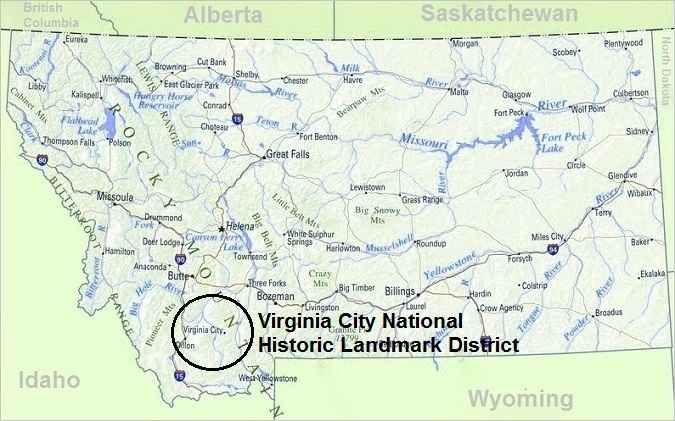Virginia City, Montana
(Includes Nevada City)
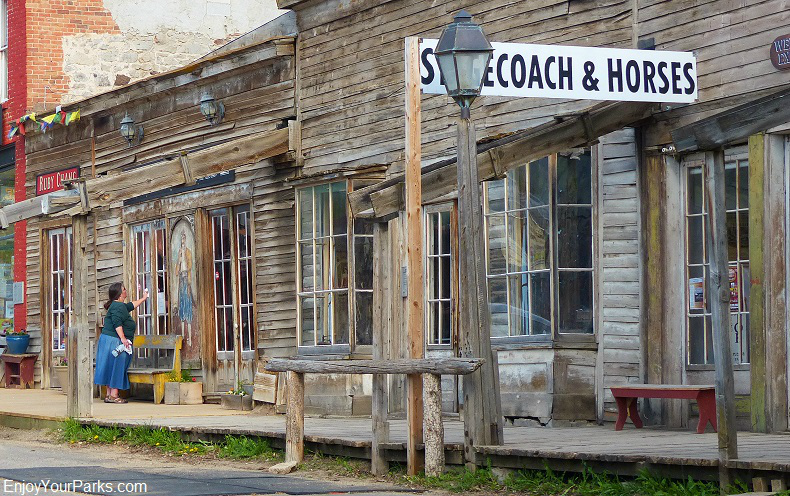
Virginia City National Historic Landmark District, Montana
Virginia City, Montana
(Includes Nevada City)
 Virginia City, Montana is one of the largest, most complete and preserved Old West Towns in the United States, having over 100 original Gold Rush Era buildings still standing. This remarkable "living" ghost town is a treasured National Historic Landmark, and every native Montanan has an immeasurably deep pride and affection for this real life piece of the Great American West. And once you walk its old boardwalks, see these unbelievably well preserved historic buildings, and learn about its colorful history that includes Road Agents and Vigilantes, you too will gain a heart-felt affection for the fascinating gold rush town of Virginia City, Montana.
Virginia City, Montana is one of the largest, most complete and preserved Old West Towns in the United States, having over 100 original Gold Rush Era buildings still standing. This remarkable "living" ghost town is a treasured National Historic Landmark, and every native Montanan has an immeasurably deep pride and affection for this real life piece of the Great American West. And once you walk its old boardwalks, see these unbelievably well preserved historic buildings, and learn about its colorful history that includes Road Agents and Vigilantes, you too will gain a heart-felt affection for the fascinating gold rush town of Virginia City, Montana.
GOLD!
 It all started in 1863 when Bill Fairweather and Henry Edgar discovered gold near Alder Creek. This discovery dramatically changed the course of history. Because Mr. Fairweather and Mr. Edgar were not very good at keeping a secret, prospectors began pouring into Alder Gulch. And because of this tremendous influx of people, on June 16, 1863 the township by the name of "Verina" was established in order to create and enforce rules about individual gold claims. The name "Verina" was meant to honor the only First Lady of the Confederate States during the Civil War. This name was chosen by the large number of confederate loyalists that were inhabiting the mining camp at the time, but because "Verina" was in Union Territory, a Union judge objected to this name choice, and registered the name "Virginia City" instead.
It all started in 1863 when Bill Fairweather and Henry Edgar discovered gold near Alder Creek. This discovery dramatically changed the course of history. Because Mr. Fairweather and Mr. Edgar were not very good at keeping a secret, prospectors began pouring into Alder Gulch. And because of this tremendous influx of people, on June 16, 1863 the township by the name of "Verina" was established in order to create and enforce rules about individual gold claims. The name "Verina" was meant to honor the only First Lady of the Confederate States during the Civil War. This name was chosen by the large number of confederate loyalists that were inhabiting the mining camp at the time, but because "Verina" was in Union Territory, a Union judge objected to this name choice, and registered the name "Virginia City" instead.
Within weeks of the formal designation of Virginia City, thousands of men flocked to the townsite to strike it rich, making it a full fledged boom town. Located in an incredibly remote section of the Idaho Territory, the town was in the center of basically a lawless land. The complete lack of a justice system, other than a miner's court, inevitably gave way to some notorious criminal activity. At the top of list of this criminal behavior was robbery and murder.
Stage coaches carrying gold and/or money were constantly being robbed by road agents, and the town of Virginia City was a dangerous place, even walking down main street during the middle of the day! Gunfights were commonplace during all times of the day and night, and it was as classic of a Wild West Town as any Hollywood movie has ever depicted. And by the way, the Alder Gulch gold strike was and still remains the richest placer gold strike in the world.

Visitors enjoying their stroll along Virginia City's main street.
Bannack, Montana: Strong Connection To Virginia City
One year earlier, in 1862, gold was discovered 80 miles to the west of Virginia City on Grasshopper Creek. This was the first major gold strike in Montana, and the mining town of Bannack sprang up overnight. Thousands of men rushed to Bannack in search of gold. Shortly after that Bannack became the first Territorial Capital of Montana. But when gold was discovered in Alder Gulch one year later in 1863, Virginia City became the center of the action. Many prospectors and businessman left the town of Bannack and moved to Virginia City in 1863, and shortly after that the Territorial Capital of Montana moved its location to Virginia City as well.

Virginia City Montana is the largest intact Old West Gold Rush Towns in America.

Visitors walking along the boardwalk of Virginia City's historic main street.

There is a fantastic antique fire engine tour that is a "must do" while exploring Virginia City! You'll learn all about the legendary stories that made Virginia City one of the most fascinating Old West Gold Rush Towns in the country!

Visitors enjoying a stagecoach ride on Virginia City's main street.
Villians and Vigilantes
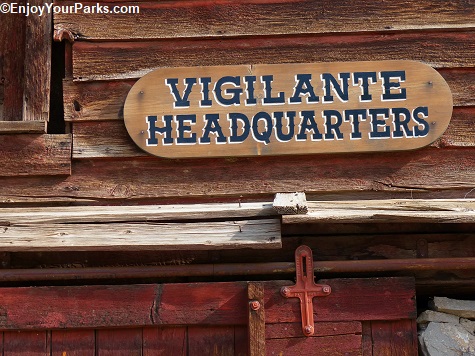 Due to the lawlessness of the Virginia City and Bannack areas during the early gold rush days, some infamous Montana outlaws emerged. They called themselves "The Innocents", and were basically notorious road agents who were responsible for a majority of robberies in and around Virginia City in 1863, as well as over 100 murders. They robbed many a stage coach travelling between Bannack and Virginia City, in addition to the assorted other methods of robbing their victims. In time, the God-fearing locals who wanted to put an end to this lawlessness created a secret group of men known as "The Vigilance Committee", also known as "The Montana Vigilantes". The Montana Vigilantes secretly organized in December of 1863, and immediately began to "clean house" in Virginia City and Bannack.
Due to the lawlessness of the Virginia City and Bannack areas during the early gold rush days, some infamous Montana outlaws emerged. They called themselves "The Innocents", and were basically notorious road agents who were responsible for a majority of robberies in and around Virginia City in 1863, as well as over 100 murders. They robbed many a stage coach travelling between Bannack and Virginia City, in addition to the assorted other methods of robbing their victims. In time, the God-fearing locals who wanted to put an end to this lawlessness created a secret group of men known as "The Vigilance Committee", also known as "The Montana Vigilantes". The Montana Vigilantes secretly organized in December of 1863, and immediately began to "clean house" in Virginia City and Bannack.
These heroic vigilantes went after these murderous road agents, and one by one "took care of them" by hanging. Within three weeks of the Montana Vigilantes being organized, 24 road agents were hung, most in December of 1863 and early January of 1864. Among the Road Agents that hanged from the gallows during this period was the well respected sheriff of nearby Bannack, Montana (80 miles to the west) by the name of Henry Plummer. He was actually the secret ring-leader of this notorious Road Agent Gang known as "The Innocents" that was terrorizing Virginia City and Bannack! And by the way, he was the only Road Agent that cried and begged for his life during the hangings. After this amazing "clean up job" by the Vigilantes, any remaining Road Agents fled the area with their lives and were never seen or heard from again. The days of "The Innocents" were no more.
The Mysterious Numbers 3-7-77
 The Montana Vigilantes (known as "The Vigilance Committee) used the symbol 3-7-77 during their "clean up" of Virginia City and Bannack Montana. They would paint these numbers on cabins and tents of men who were about to receive vigilante justice as a warning.
The Montana Vigilantes (known as "The Vigilance Committee) used the symbol 3-7-77 during their "clean up" of Virginia City and Bannack Montana. They would paint these numbers on cabins and tents of men who were about to receive vigilante justice as a warning.
There are several theories as to what these mysterious numbers actually mean. One theory is that it is the dimensions of a grave: 3 feet wide, 7 feet long and 77 inches deep. Another popular theory is that the criminal had 3 hours, 7 minutes and 77 seconds to leave town.
We may never know the true meaning of these ominous numbers, but they are presently found on the shoulder patch of every member of the Montana Highway Patrol, and these numbers also appear on the flight suits of the Montana Air National Guard pilots and the flight patch of the Montana Army National Guard Medevac Unit. You will also find it under the bottle caps of some Montana-made beers.
The Hangman's Building

The Hangman's Building is located on the historic main street of Virginia City.
 On January 14, 1864, the Vigilantes captured 5 notorious road agents, and hung these men from a support beam inside this building. The building was under construction at the time, and the roof was not yet built.
On January 14, 1864, the Vigilantes captured 5 notorious road agents, and hung these men from a support beam inside this building. The building was under construction at the time, and the roof was not yet built.
This open-beamed, unfinished building proved to be the perfect place for a hanging. Frank Parish, Boone Helm, Jack Gallagher, Haze Lyons and Clubfoot George met their maker on that fateful January day. All of these men were part of Sheriff Henry Plummer's Road Agent Gang.
The original support beam remains intact and is exposed for visitors to observe (see photo). If you look carefully at the beam, you can see indentations where some of the ropes were located during the actual hanging. There is a small museum inside the building that walks you through that January day in Virginia City. Sheriff Plummer was hanged shortly after in Bannack Montana.

This display is located inside the Hangman's Building to help visitors re-live the hanging of 5 Road Agents on January 14, 1864. As you can see, one of the Road Agents jumped off his box on his own.
David's Pioneer Ancestors...They Were There!!!
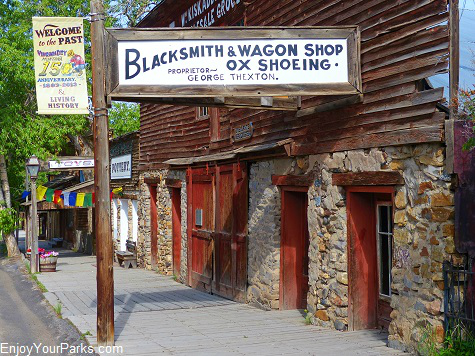
Originally from Maine, David's great great great grandparents, William and Clara Dalton, came to Montana on the First Fisk Expedition in 1862. This harrowing adventure through the middle of the untamed Wild West, took the Daltons from St. Paul, Minnesota to Fort Benton, Montana. From there, they then traveled hundreds of miles, across the continental divide, to reach the gold rush town of Bannack Montana. Bannack was the first gold rush town in Montana, and was located about 80 miles west of Virginia City, which later became Montana's first territorial capitol. William and Clara Dalton brought their four children with them on this unbelievable adventure, which included their 18 year old daughter Matilda Dalton and three younger children, by the names of Alvin, Orrin and Margaret.
They arrived in Bannack on a cold December day in 1862, just 5 months after gold was first discovered here.
One year after settling in Bannack, the Daltons then moved to the brand new gold rush town of Virginia City in January of 1863, which was located about 80 miles to the east of Bannack.
(By the way, these Daltons are not related to the notorious "Dalton Gang" of Missouri and Kansas. However, being on David's mother's side of the family, David's father Oscar would more than occasionally joke with Dave's mother Jeanne that William and Clara were indeed part of the infamous Dalton Gang, which of course would raise his mother's blood pressure...to say the least!)
 Matilda Dalton was one of the very few young single women in the entire town of Virginia City, and being part of a well educated, God-fearing family, and from all accounts being drop-dead gorgeous, she more than likely had to beat the men away with a really big club! Matilda Dalton was called by the locals "Desdemona" after Shakespeare's "Othello", because she was so beautiful. Many years later in her late eighties, Matilda wrote that there was a rumor floating around Virginia City when she lived there as a young woman that a man actually shot himself in the head because he couldn't win over young Matilda's heart.
Matilda Dalton was one of the very few young single women in the entire town of Virginia City, and being part of a well educated, God-fearing family, and from all accounts being drop-dead gorgeous, she more than likely had to beat the men away with a really big club! Matilda Dalton was called by the locals "Desdemona" after Shakespeare's "Othello", because she was so beautiful. Many years later in her late eighties, Matilda wrote that there was a rumor floating around Virginia City when she lived there as a young woman that a man actually shot himself in the head because he couldn't win over young Matilda's heart.
Matilda also told the story of when her father William Dalton was walking across the main street of Bannack when he crossed paths with Henry Plummer, the highly respected sheriff of Bannack,Montana. William introduced himself and reminded Henry that his parents Ed and Rial Plummer and their children (including young Henry) lived near William and Clara and their children (including Matilda) shortly after they moved to Wisconsin around 1843 near Portage City. (The Plummers were originally from Maine, just as the Dalton's were.) Sheriff Plummer denied knowing William and kept walking. Matilda said her father William was very puzzled by this, and mentioned it to Matilda and Clara that night at dinner. He couldn't understand how Henry Plummer couldn't remember him, as their families lived near each other for eight years and were not only neighbors but also friends.
What William Dalton didn't know was that Sheriff Plummer had actually killed a man in California several years earlier before moving to Montana, and was therefore running and hiding from his past. Not long after her father William crossed paths with Sheriff Henry Plummer on the main street of Bannack, Plummer was hanged in Bannack by the Vigilantes in early January of 1864, after it was discovered that he was the secret leader of the notorious Road Agent Gang.
 About a year after the Daltons moved from Bannack to Virginia City, Matilda became ill during the horrific Typhoid Fever Epidemic that ran rampant throughout the young mining town. After caring for Matilda, her mother Clara became ill, and sadly both William and Clara died of Typhoid Fever within two weeks of each other in January of 1864. William Dalton's funeral was the second Masonic Funeral in what is now Montana. Matilda survived the epidemic, and was left raising three young siblings at the age of 19 in an old west mining town. This was not the best place for a young single woman to try and raise three young siblings.
About a year after the Daltons moved from Bannack to Virginia City, Matilda became ill during the horrific Typhoid Fever Epidemic that ran rampant throughout the young mining town. After caring for Matilda, her mother Clara became ill, and sadly both William and Clara died of Typhoid Fever within two weeks of each other in January of 1864. William Dalton's funeral was the second Masonic Funeral in what is now Montana. Matilda survived the epidemic, and was left raising three young siblings at the age of 19 in an old west mining town. This was not the best place for a young single woman to try and raise three young siblings.
Later that year, following the death of her parents, Matilda married Count Zebulon Bonaparte Thibadeau of Virginia City in 1864, and shorty after that they moved back to Oshkosh, Wisconsin for several years where they had 3 children of their own: William Wallace, Estelle and Helena. William Wallace is David's great grandfather.
Matilda and Zebulon then moved back to the west where he owned a pack train business that ran between Idaho and Montana. Zebulon died in 1894 in Wallace Idaho, and Matilda passed away in December of 1931 at the age of 88. In her later years, Matilda attended several Montana Pioneer Reunions, including her first reunion in 1918 held in Anaconda. Matilda Dalton-Thibadeau was a proud Montana Pioneer who understood what an illustrious time she was a part of, and just how impactful these gold rush days were in setting the course for what became present day Montana. Matilda is buried in Dillon Montana, which is quite fitting as Dillon rests along the Old West Trail that runs between Bannack and Virginia City. The above photograph of Matilda standing by David's mother when she was just a one year old baby (being held by her father, Clarence), is an astounding illustration of just how "not-so-long-ago" all of this incredible history unfolded.
The Story of Boot Hill and William & Clara Dalton's Grave Site
 As the Montana Vigilantes were "cleaning house" in Virginia City and Bannack by shooting or hanging as many Road Agents as they could get their hands on, a handful of these criminals were buried on what is known as "Boot Hill" in Virginia City, along with many of the other law abiding citizens of Virginia City.
As the Montana Vigilantes were "cleaning house" in Virginia City and Bannack by shooting or hanging as many Road Agents as they could get their hands on, a handful of these criminals were buried on what is known as "Boot Hill" in Virginia City, along with many of the other law abiding citizens of Virginia City.
Because the good citizens did not want to be associated with this band of outlaws, the surviving family members moved the graves to another hill, away from the Road Agents graves.
But because Clara and William Dalton did not have any family members living in the vicinity of Virginia City at the time of the move, their graves remained on Boot Hill. Then in the early 1920's, their grandchildren (Matilda's children) came to Virginia City and placed a new headstone and surrounded the grave site with a two foot high stone wall.
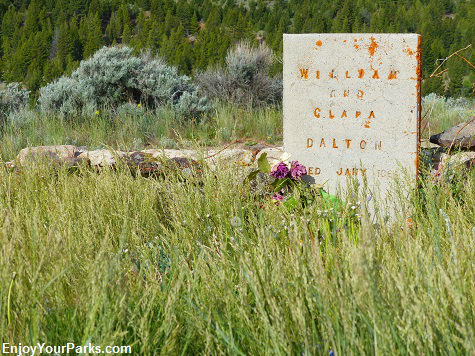 In the late 1970's, David's mother contacted the State of Montana and Montana Historical Society, and asked them to place a sign near William and Clara's graves explaining they weren't part of the Road Agent Gang.
In the late 1970's, David's mother contacted the State of Montana and Montana Historical Society, and asked them to place a sign near William and Clara's graves explaining they weren't part of the Road Agent Gang.
This sign still stands today, as well as William and Clara's grave marker and stone wall surrounding it. David and his entire family are extremely proud of their Montana Pioneer Heritage.
Being sixth generation Montanans, you could say that David and his three sisters and brother have very, very deep Montana roots to say the least... but not as deep as his great nephews and great niece, who are 8th generation Montanans. To think of what it took for us to be here.... A harrowing expedition across the untamed Wild West on a wagon train, surviving Typhoid Fever, and surviving probably the roughest mining town in America, it all unfolded and here we are, many generations later. David remarked that as he was recently photographing William and Clara Dalton's grave site, he was completely alone on Boot Hill on a quiet summer evening. It was at that moment when it truly hit home that if it not were for his great, great, great grandparents' bravery, their entrepreneurial spirit and their zest for adventure, he would not be standing there. He quietly thanked them.

William and Clara Dalton's Grave with the sign explaining why they are buried next to Road Agents on Boot Hill. This sign was placed as a result of David's mother and her sister working tirelessly with the State of Montana and the Montana Historical Society in the 1970s.

The sign that explains why William and Clara Dalton, David's Great Great Great Grandparents, are buried on Boot Hill beside members of the notorious Road Agents.
The "Living" Ghost Town of Virginia City
 Virginia City is the largest intact original town of the "Gold Rush Era" in the entire country, and is a tremendously popular tourist destination. You will walk the old boardwalks and peer into the original building along Virginia City's main street. And beyond main street, a large portion of the town still has the original homes of the gold rush days, which is absolutely remarkable. About 195 people still live in Virginia City, and because Virginia City is the county seat of Madison County Montana, the original brick court house is still used today.
Virginia City is the largest intact original town of the "Gold Rush Era" in the entire country, and is a tremendously popular tourist destination. You will walk the old boardwalks and peer into the original building along Virginia City's main street. And beyond main street, a large portion of the town still has the original homes of the gold rush days, which is absolutely remarkable. About 195 people still live in Virginia City, and because Virginia City is the county seat of Madison County Montana, the original brick court house is still used today.
Virginia City once had a population of over 10,000 people during the Gold Rush Era in the 1860's, but when gold was struck near Helena, Montana in 1865, a large portion of Virginia City's inhabitants left Virginia City and rushed to Helena. Ever since this mass "exodus" occurred, Virginia City was essentially abandoned and time seemed to completely stop in this once booming town. But because Virginia City became "frozen in time", this old west town became a national treasure, and is far more valuable than the gold that created it.
Virginia City Opera House

The Virginia City Opera House on the main street of Virginia City Montana.
Among the 100+ original buildings in Virginia City, many of them with their original artifacts, is the Virgina City Opera House. Originally called the Old Stone Barn Theatre, this amazing building provides live entertainment in the same spirit of the Gold Rush Era, including vaudeville variety acts and old fashioned melodramatic plays. "The Virginia City Players" have been putting on wonderful shows in this historic opera house since 1948, and is an absolute "Must See and Do" during your visit to Virginia City. It will take you directly back to the Gold Rush Era more than you could ever imagine, and who knows, since the Virginia City Opera House is known to be one of the most haunted buildings in Virginia City, you might get a glimpse of one of the several ghosts that have been seen wandering the building.
Alder Gulch Shortline Railroad, And Much More!
 During your visit to Virginia City, there are many things to do in addition to exploring all the original structures. There are stage coach rides, an incredible museum, historic tours, visitor center, charming gift shops, restaurants, the historic Fairweather Inn that is still an active hotel, the historic Bale of Hay Saloon that rests next door to the opera house which provides live music all summer long, the "Brewery Follies", which is live entertainment in the original Virginia City Brewery of 1863, and a train known as the "Alder Gulch Shortline Railroad" that takes visitors to and from the neighboring ghost town of Nevada City, Montana.
During your visit to Virginia City, there are many things to do in addition to exploring all the original structures. There are stage coach rides, an incredible museum, historic tours, visitor center, charming gift shops, restaurants, the historic Fairweather Inn that is still an active hotel, the historic Bale of Hay Saloon that rests next door to the opera house which provides live music all summer long, the "Brewery Follies", which is live entertainment in the original Virginia City Brewery of 1863, and a train known as the "Alder Gulch Shortline Railroad" that takes visitors to and from the neighboring ghost town of Nevada City, Montana.
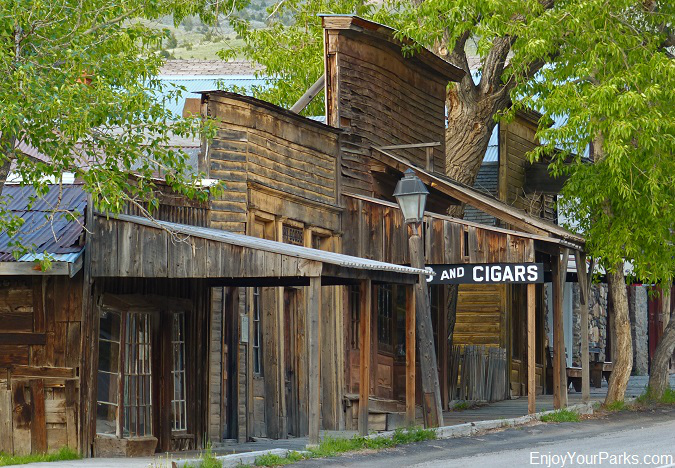
The main street of Virginia City is lined with nothing but original gold rush buildings of the early 1860's.

Madison County Court House

Virginia City Museum

Pioneer Bar
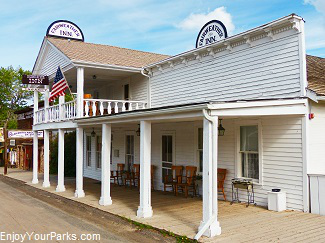
Fairweather Inn

This is a view of Virginia City and Alder Gulch from the top of Boot Hill.
Still Looking For "The Mother Load"
By the way, even though billions of dollars worth of gold has been extracted from Alder Gulch, and even though Alder Gulch was the richest placer gold strike in the world, no one has ever found "The Mother Load" from where all this placer gold originated from. Still today there are prospectors searching for this legendary "Mother Load" high in the hills above Alder Gulch.... maybe you will find it on your way through this colorful and illustrious gold rush town!
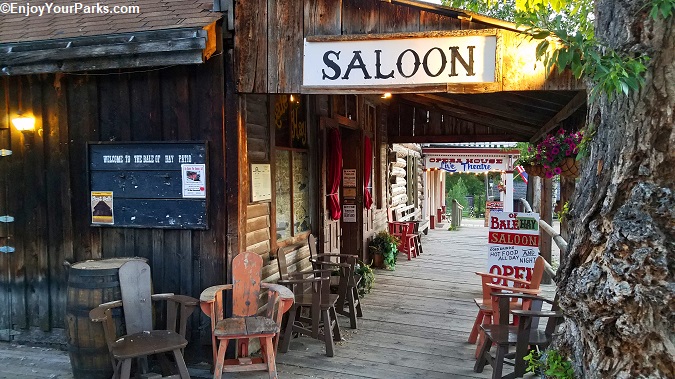
The historic Bale of Hay Saloon on the main street of Virginia City, located next to the Opera House.
Nevada City, Montana
 Nevada City was also established in 1863 and served as an additional mining camp as prospectors combed Alder Gulch looking for gold. This fascinating ghost town is less than 2 miles northwest of Virginia City along the main highway, and is also a "Must See" while visiting this historic area. In addition to 14 original buildings that are wonderfully preserved, the Montana Heritage Commission and other entities have been "saving" historic structures throughout the state of Montana, and have relocated them to Nevada City. To date there are over 108 historic buildings that have been relocated from various locations throughout Montana and are now part of this amazing outdoor museum. In addition, Nevada City's Music Hall is home to the largest collection of automated music machines in North America.
Nevada City was also established in 1863 and served as an additional mining camp as prospectors combed Alder Gulch looking for gold. This fascinating ghost town is less than 2 miles northwest of Virginia City along the main highway, and is also a "Must See" while visiting this historic area. In addition to 14 original buildings that are wonderfully preserved, the Montana Heritage Commission and other entities have been "saving" historic structures throughout the state of Montana, and have relocated them to Nevada City. To date there are over 108 historic buildings that have been relocated from various locations throughout Montana and are now part of this amazing outdoor museum. In addition, Nevada City's Music Hall is home to the largest collection of automated music machines in North America.

The historic Nevada City Hotel.

There's a wonderful antique steam engine train that takes visitors between Virginia City and Nevada City.
Robbers Roost Near Alder Montana... A Hang Out For Road Agents.

Robbers Roost near Alder, Montana was a popular hang out for Road Agents.
In 1863, a man named Pete Daly built a roadhouse at this location to serve the men and women traveling between Bannack and Virginia City. This also was where there were under-cover Road Agents (known as "The Innocents") who would find out which of the travelers and/or stage coaches were the ones carrying gold or money. They would befriend unsuspecting travelers, and carefully listen to their conversations to gain information on who was worth robbing. Then as these unsuspecting travelers would make their way between Bannack and Virginia City, the Road Agents would ambush and rob them. Robbers Roost is located along State Route 287, several miles west of Nevada City along Alder Creek near Alder, Montana.

Virginia City Montana and Nevada City are a "must see" during your Montana vacation!



